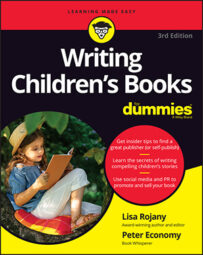Lots of writers and writer/illustrators these days are opting to self-publish instead of going the traditional route of submitting directly to agents, publishers, or art directors. There are some special considerations when it comes to self-publishing an illustrated book. If you’ve taken on the role of the self-publisher and are working on an illustrated children’s book, consider the following tips:
Find an illustration style to match your story. There are as many ways to illustrate a book as there are to write it. Look at already published books and see how various illustrators realize their styles. Decide on a few that you like.
Find an illustrator. If you have ample resources, you can track down the exact illustrator whose style you like and inquire as to her interest, price, and availability. In the event your funds aren’t overflowing, you can take the example of a style you love and use it to find other, hungrier illustrators who create art in a similar style.
Research. Go to both online and real-world venues where children’s book artists hang out and promote their wares. If you can’t find anyone through the Society of Children’s Book Writers and Illustrators, you can check out art colleges, book conferences, or the annual comic book convention in San Diego.
Put together a written agreement. Before contacting the illustrator, decide whether you want to pay the illustrator a flat fee or partner with him, sharing in the proceeds (and hope that he is amenable or willing to negotiate).
After you agree on fees and basic scheduling, you both should sign and date a contract, which usually involves hiring an entertainment or publishing attorney and should cover, at minimum, the scope and quantity of illustrations to be produced (how many sketches, pencils, pieces of color art, and corrections will be considered reasonable); formatting instructions, including size, black-and-white versus color, and so on; any pre-production preparation of art; the book design and layout fee (if both parties are splitting the cost, irrelevant if not); the total amount to be paid the illustrator (for example, a flat fee or an advance against a portion of the book’s royalties); a schedule for payment; whether the illustrator will transfer or retain rights to the illustrations — and be specific regarding which rights; and a schedule for delivery of sketches, pencil illustrations , final color art, and any corrections.
An element that’s just as important as a contractual agreement is the feel-good mojo between you and anyone you work with — especially someone with whom you partner to realize your lifelong dream in book form. Get references and ask pertinent questions about working with that person before you hire him or her.
Establish open communication. Open communication between the two of you about what you both expect in terms of your involvement in the illustration process and its details ensures you start off on the right foot — and stay there. One way to make sure you’re on the same page is to create a sample page together — another reason spending time on sketches up front will save time and heartache later in the illustrating process.
Pay attention to the details. Here’s a checklist for what makes good art great:
The images not only complement the text, but also provide spark and personality, earning their space on the page. Some illustrations may replace text; others may add an all-important layer of deeper meaning. Regardless, each page or spread has to come alive with an exceptional interpretation of an active part of the story.
The images employ different perspectives from page to page, focusing on different aspects of the main character and taking place in different parts of the scene or context of the story.
There’s consistency from page to page, spread to spread, regarding characters and backgrounds (if a shoelace is untied on the first page, it should remain so throughout; if your main character’s eyes are hazel, better make sure they don’t turn blue all of a sudden).
The images also incorporate variety. There is nothing more boring than viewing inherently the same illustrations throughout an entire book. Intersperse spot art against a white background with a spread of full-bleed art here and there.
Give readers the world as it appears from a short person’s point of view (POV) looking up instead of always looking down at them. Give readers three-quarter views and aerial perspectives instead of just front and side views.
Although different illustration styles require different focal characteristics, all must have that little something that appeals to children — be it charm, personality, simplicity, sweetness, humor, quirkiness, or plain old goofiness. Good illustrators (and good publishers) pay attention to all of these issues as well as to each and every minuscule detail.

